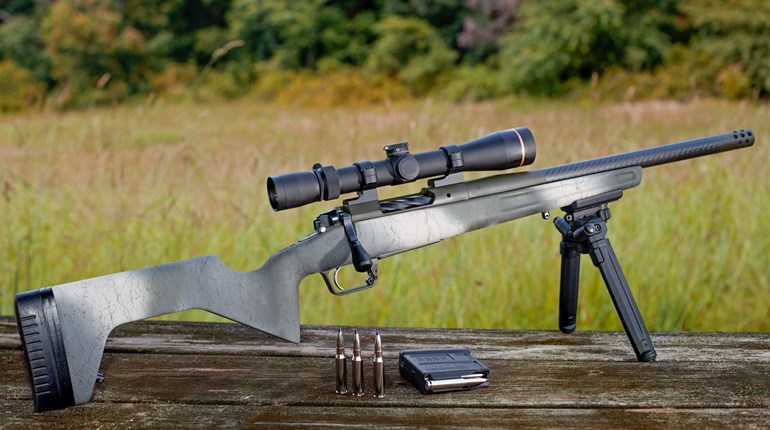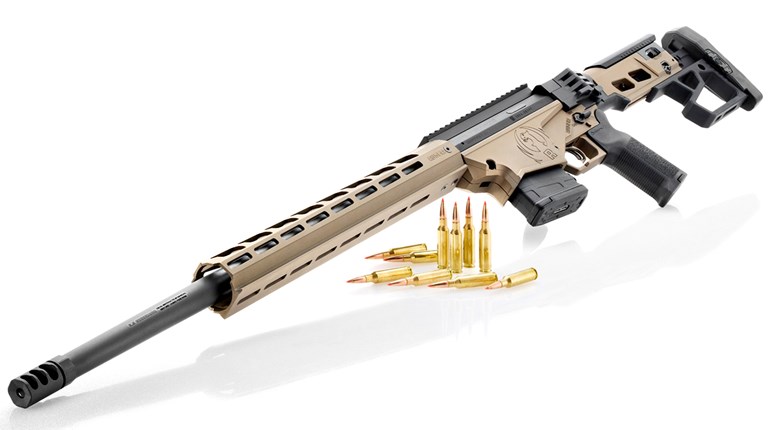
A few years ago, the makers of bolt-action rifles seemed focused on building rifles that could reliably shoot groups under an inch at 100 yards. At the time, consistent 1-MOA shooters were all but routine among factory-produced rifles and, when you found one that would shoot better than that, you hung onto it. For a variety of reasons, factory rifles these days can usually shoot better than MOA—often far better. We are in the heyday of the precision rifle, with factory models besting the most-expensive custom rifles of yesteryear. With great accuracy more or less achievable by most makers, the trend has turned toward making that kind of precision affordable. Thompson/Center Arms has always delivered value to its customers and, with the introduction of the Performance Center Long Range Rifle (LRR) Bolt Action, it has made a precision rifle that will fit most shooters’ budgets.

The Performance Center T/C Long Range Rifle is a chassis-style precision rifle that incorporates many features considered desirable for long-range shooting. Essentially, this rifle is intended to be a reasonably priced turnkey setup for precision-shooting customers. At its core, the LRR uses the same turnbolt short action as other T/C designs, including the Compass. Our test rifle was chambered in the popular 6.5 Creedmoor, but the rifle is also available in .308 and .243 Win. for those who haven’t received the memo.
The 4140 steel receiver uses a three-lug bolt which has become a common feature on budget-priced bolt-action rifles. The reason? They shoot well. Another virtue of the three-lug bolt used on the LRR is that it makes for a short bolt throw, since the surface area of the individual bolt lugs is decreased and it takes less rotation to unlock the lugs from their seats. This bolt rides on a longitudinal groove on the left side of the body that engages on the action’s bolt stop; this anti-bind feature eliminates much of the “slop” as the bolt is cycled. Still, there’s something about T/C bolt design or the geometry of its bolt handle that makes them a bit awkward for me—perfectly functional, but not smooth. The two-position safety is mounted on the right side of the action, just forward of the tang to the rear of the bolt handle. Pressing the lever forward places it in the “fire” position. The bolt can be cycled with the safety engaged, which is a good thing.

Extraction is facilitated via a sliding steel hook that rides inside a T-slot in one of the bolt’s locking lugs and a plunger-style ejector extends from the bolt face on the opposing side. Unlike some custom rifles I’ve encountered lately, the LRR will reliably eject loaded rounds.
The Performance Center T/C Long Range Rifle ships will a steel 10-round, detachable-box magazine. The magazine tapers to the single column so that the cartridge feeds directly into the chamber and leaves little room for feeding errors. The magazine box also measures 2.90 inches internally, giving handloaders a little room to experiment with overall cartridge length. We were unable to load more than nine rounds into the magazine and our attempt to cheat the system by hand-feeding a cartridge into the chamber and then inserting the mag resulted in a bolt that was tied up due to the upward pressure of the full-loaded magazine.
The 24-inch 5R-rifled barrel is made from 4140 steel and comes fit with a four-port muzzle brake that is effective in reducing the rifle’s felt recoil. If a different muzzle device is desired, the 5⁄8-24 tpi threads mean the LRR is compatible with most products on the market, including suppressors. The barrel is also fluted with five substantial flutes that provide additional surface area for cooling and cut a nominal amount of weight.
The most visibly and functionally unique component of the LRR is the aluminum-chassis stock. Chassis stocks have become popular for a handful of reasons. They provide an extremely rigid bedding platform, especially when compared to some of the flimsy injection-molded stocks on the market and can often produce excellent accuracy without the need for glass bedding. Chassis systems, like the one used on the LRR, also facilitate dimensional adjustment to suit the varying physical needs of different shooters and optics. Finally, chassis stocks make the attachment of accessories a straightforward task.
The aluminum chassis on the Performance Center T/C Long Range Rifle is available in either a black or Flat Dark Earth Weather Shield finish and secures to the action using two hex screws. The stock is user-adjustable for both length-of-pull and comb height using two independent wheel adjustments. The rear area of the stock is skeletonized, presumably to save weight, and a sweep of the toe line serves as a hand stop for the support hand during firing. The chassis accepts AR-style pistol grips and a grippy rubberized model with three finger grooves comes standard. The barrel is generously freefloated forward of the recoil lug and the M-Lok-compatible fore-end has 32 slots to facilitate the mounting of accessories such as bipods, lasers and barricade stops. A Caldwell bipod, complete with M-Lok attachments, is included with the LRR.

No rifle built for precision shooting is of much use if it doesn’t possess a good trigger and T/C did things right on the Performance Center T/C Long Range Rifle. The single-stage Performance Center trigger has a blade-style safety lever inside the trigger’s face, similar in-design to the Savage AccuTrigger. Thanks, I’m certain, to the addition of this device, our test rifle’s trigger broke at a clean and consistent 2.5 pounds. The trigger is adjustable to up to 3.5 pounds if one prefers a heavier pull.
Thanks to the rifle’s 11.5-pound weight, the well-behaved 6.5 Creedmoor cartridge and the effective muzzle brake, the LRR was extremely pleasant to shoot. I generally wear a shoulder pad when testing rifles to take as much of the human element out of the equation as possible, but didn’t bother on this test. I fired over 100 rounds from the bench in a single shooting session and at no point did recoil become a factor. Thanks to the lack of recoil and the optical quality of my test scope, calling hits, even on paper targets, was a fairly common occurrence.

I mounted a Leupold Mark 5 HD 5-25x56 mm optic to the 20-MOA Picatinny rail and, within two shots, had a precise 100-yard zero. This scope sits pretty high on the rifle but, thanks to the adjustable comb, I dialed-up easily to accommodate its height. Thompson/Center advertises the rifle as being capable of 1-MOA-or-better three-shot groups with premium factory ammunition and I was able to beat that standard by a wide margin. My five-shot groups with both 140-grain. ELD-M Hornady Match and 130-grain HPBT Prime Match+ ammunition averaged in the .54- to .7-MOA range, and my best groups were inside of .5 MOA at 100 yards. Moreover, each load shot to the same point-of-impact.
As noted previously, the Performance Center T/C Long Range Rifle functioned 100 percent so long as I didn’t baby the bolt or try to load 10 rounds into the magazine.
With an MSRP of $1,211 and a street price that’s sure to be lower, the Performance Center LRR is a great deal of rifle for the money. The Precision Rifle Series has a Production Division that caps the MSRP of qualifying rifles at $2,000—given the price point, accuracy and included features, the LRR could be a contender in that division. The rifle comes in a well-executed black nylon case so the user need only purchase a scope and rings to be range-ready. A rifle that shoots this well and is packed with this many features isn’t something to sneeze at. Add in the included accessories and a very reasonable price tag, and you’ve got the “everyman” precision rifle.





































